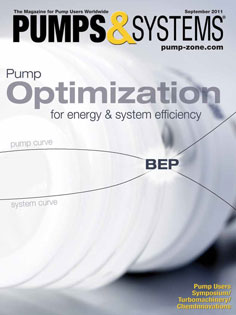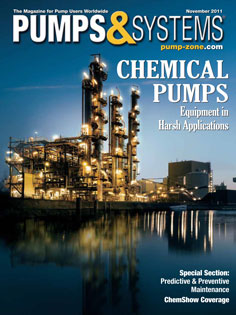“Temperature and Vibration Signals,” September 2011
Click here for full article.
 As a dedicated reader of Pumps & Systems, I find this magazine a wealth of knowledge to the people in water and wastewater industry. Every time I pick up a copy, I read articles that are really on track to the challenges we face in the reliability of our assets.
As a dedicated reader of Pumps & Systems, I find this magazine a wealth of knowledge to the people in water and wastewater industry. Every time I pick up a copy, I read articles that are really on track to the challenges we face in the reliability of our assets.
In you September 2011 edition, I was a little taken back by the "Temperature and Vibration Signal" article on page 66. The article starts out informational but in the end it wraps up sounding like an advertisement. I have a staff of reliability technical specialist that performs the vibration collection/analysis, infrared thermography, ultrasonic testing and motor winding analysis for our company.
In the September article, it sound as if I can purchase a handheld vibration test and a thermal imager and give it to anybody, and they can learn how to use them in a matter of a few minutes. The closing section of this article does not do justice to the dedicated certified vibration analyst and thermographers, who go through training, spend countless hours learning the expertise and take third party certification examinations to perform this valuable service.
Your magazine does a terrific job bringing technical information to its reader, and I am sure the two authors are experts in their field, the great article just slanted into marketing at the end.
Please keep up the great work and the information your magazine provides, I look forward to reading next month’s edition
Wesley (Jake) Jacobs
Maintenance Manager
Michelle Segrest responds:
It is so nice to hear from you! We appreciate feedback from our readers, both positive and constructive. Thank you for giving us both!
I would like to present your comments to the authors of the article and ask them to respond and perhaps provide us with some more information that addresses your concerns. I would also like to publish your comments in our Readers Respond section of the magazine.
Again, thank you for being a loyal reader and for reaching out to me. I welcome your comments anytime.
John Bernet, Fluke Corporation, responds:
Big companies have the vast resources needed to afford a reliability team and have worked hard over the years to cultivate a company culture that appreciates the hard work of technology experts. Many of these experts have developed excellent skills and are supported by operations, maintenance, management and other departments. Smaller companies do not have the resources to have their own reliability team and rely on outsourcing this to consultants, or they simply cannot afford to reap the benefits of condition based maintenance. Technology improvements over the years have made it possible for smaller companies to see the benefits of programs that they once could not afford. A good example of this is GPS programs that the military funded and developed and now everyone can now afford to use this technology because it is cheaper and easy enough for anyone to use.
The same is true with the vibration analysis and IR thermography technologies. Amazing technological breakthroughs have dramatically changed the knowledge level required by the user. With minimal training and setup, a technician that understands the way their machine works can take a tool with proven and sophisticated software to diagnose the most common faults on their simple machines. They can’t do everything that the extremely experienced reliability team can do, but they can troubleshoot their important machines which allows the reliability team to focus on the most critical and complex machines.
“The Impact of the Area Ratio,” November 2011
Click here for the full article.
 Hi Terry,
Hi Terry,
Thanks for your interesting article published in the November issue of Pumps & Systems magazine. Even though I had heard of Mr. Anderson before, I wasn't aware of his contributions to pump design. I appreciate the background information that you shared.
I have a paper entitled "Size, Shape, and Similarity" by J. Richardson, BSc, CEng, MIMechE, Hayward Tyler Limited, Luton, Bedfordshire. In the paper, I located a reference to the area ratio method devised by Anderson given as
Y = pi D b sin(theta) / A3
In this paper, "D" would correspond with Jekat's D2, "b" = b2, "theta" = beta2, and "A3" = A4. This paper defines "Y" as the ratio of the impeller total gross discharge area (including vane blockage) to the throat area.
In Jekat's work, he plots Athr / AII (i.e., A4 / AR2 or 1 / Y). He defines AII (i.e., AR2) = b2 [2 pi r2 sin(beta2) – z s2] where s2 = t2. In Jekat's work, AII / Athr (i.e. "Y") is the ratio of the impeller total net discharge area (excluding vane blockage) to the volute throat area.
Per the above works, shouldn't the article AR2 be multiplied by the number of impeller vanes "z." That is, shouldn't AR2 = z b2 LR2? Also, I assume that the article equation (2) constant 275 should have been 2750.
Lee Ruiz
Oceanside, CA

